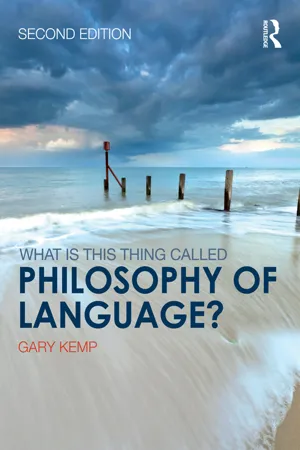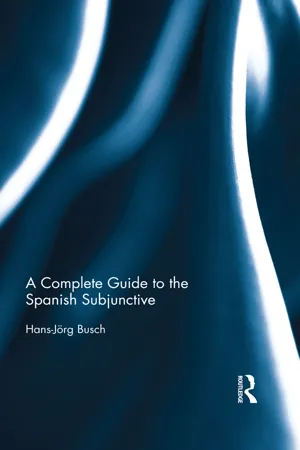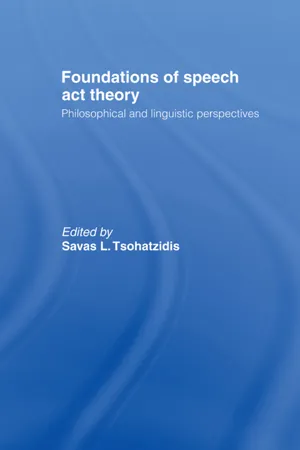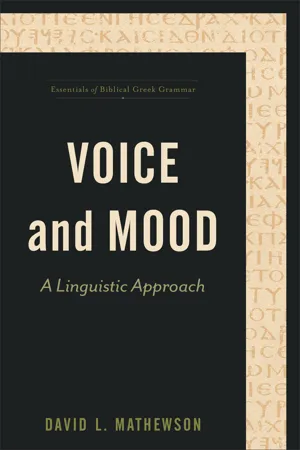Languages & Linguistics
Imperative Mood
The imperative mood is a grammatical mood used to express commands, requests, or direct suggestions. It is typically used to convey a sense of urgency or authority. In English, imperative sentences often begin with a base form of the verb and do not include a subject, as in "Close the door."
Written by Perlego with AI-assistance
Related key terms
6 Key excerpts on "Imperative Mood"
- eBook - ePub
- Augustine Agwuele, Adams Bodomo(Authors)
- 2018(Publication Date)
- Routledge(Publisher)
Examples (41a) and (41b) constitute a continuous flow of text (cf. endnote 9). The command here is directed to a plural interactant, signalled by the Vocative element at the beginning of the clause. The Predicator in the first clause requires a person prefix because it is in the prohibitive mood. However, the Predicator in (41b) cannot take a person prefix since it is non-prohibitive. The implication is that the prohibitive clause has the same structural form as a corresponding declarative clause. The difference is indicated by a high-low tone on the pronominal subject prefix in the declarative and a low-high tone on that of the imperative clause.Another contrast in the Imperative Mood across languages is that between immediate and non-immediate imperatives, although it seems this is not a common distinction. It has been reported in Zulu (van Rooyen, 1984) and is prominent in Mabia languages (e.g., Dagaare, Dagbani, Gurene, Mampruli), as a sub-distinction within the prohibitive mood. It is exemplified in (40b) and (40c), where respectively the immediate prohibitive is realized by the negative imperative particle di and the non-immediate is realized by a distinct negative particle diti . In Dagaare, the non-immediate requires an imperfective verb form in addition to the particle.In addition to these imperative sub-types, a subjunctive mood is predominant in the southern Bantu languages such as Swahili, Zulu and Sotho and it is realized by a distinct verbal morphology (cf. van Rooyen, 1984).10Another important typological variable is the interaction of the imperative with the PERSON system. Three generalizations can be made in relation to this variable:p.1131 The imperative occurs with all persons – interactant: speaker/speaker plus; interactant: addressee (singular/plural) and non-interactant.2 A Subject (for languages where it is always a separate element) or a pronominal subject affix (realized in the Predicator) is required in the Imperative Mood except where modal responsibility is assigned to a singular addressee.3 As an alternative to 2, in some languages a pronominal subject affix is required for the prohibitive (i.e., negative imperative) mood but is absent in the non-prohibitive (i.e., positive imperative) mood.Generalization 1 is found in all the languages where data on the imperative is accessible to us (e.g., Akan, Dagaare, Dagbani, Ga, Gurene, Kulango, Ọ̀kọ́), and perhaps applies to all Niger-Congo languages. Variable 2 is also dominant in Niger-Congo in comparison to 3. Examples can be found in (3c, d) introduced earlier and repeated below as (42a, b): - eBook - ePub
- C. I. Lewis, John Lange(Authors)
- 2017(Publication Date)
- SUNY Press(Publisher)
instruction of the addressee as to the mood in which they are to be understood: “Believe me that —,” “Suppose that —,” “Consider whether —,” “Take it as probable that —,” etc. But such renditions would not, of course, be generally and correctly interpretable as “commands.”We may still say that, divested of its metonymic extensions, and corrected for inexact elisions, the indicative is the mood of assignment to the representational content expressed the status of that which is actual, fixed, inalterably as it is and not otherwise. In a similarly general fashion, we may say that the basic sense of the imperative is the entertainment of the thought-of content of representation as future determinable and as a commitment to be taken. Some represented and referred-to state of affairs is to be brought about. But at once two semantic cautions are to be observed. First, though our main interest here is in doing, in physical bringing about, we must not forget that directable thinking is itself an activity and has its own critical directives, which constitute the topic of logic and epistemology—the ethics of believing. Such governable thinking may also and literally fall under the head of the future determinable, but in a somewhat different sense from that with which doing is concerned. Second, we must not confuse the communication of a content expressed in the Imperative Mood with the imposing of a requirement to do upon the addressee. Imparting to another the imperativeness of something to be done is not—or not universally—commanding the addressee to do it, or even urging or exhorting him to do it. For example, one who instructs another how something must be done if the doing of it is to succeed in its aim is not laying on him a command to do anything, or, even if he does something relevant, to do it as instructed. The instructor may have no desires with respect to what his advisee shall do or how he shall act, and might be better pleased if he would stop bothering a busy man and go make his own mistakes. But the discourse of such instruction will fall in the Imperative Mood. And, even if it is unlikely, one who is called upon to instruct another how to live a good life in harmony with his neighbors might be similarly irked. The supposition that discourse having to do with the moral is either commanding to do or persuading to do, whether for the sake of, or for some advantage to, or for any other purpose of, the communicator begs the question whether or not there is a reason - Gary Kemp(Author)
- 2017(Publication Date)
- Routledge(Publisher)
purposes – these figures have been so successful that the basic framework that emerged from their work has, for over 40 years now, served as a touchstone for the mainstream philosophy of language and theoretical linguistics. In this chapter, we will explore its initial forms and motivations and consider some applications.• Mood and Force Revisited
In the Introduction, we distinguished meaning from force . Semantics concerns the former, and pragmatics is largely concerned with the latter. The sentences in Table 7.1 , we said, express the same proposition but would normally be used to express it with different force . The grammatical differences are differences of mood .Table 7.1 Mood and forceSentence Mood Force (that would standardly be expressed by that mood) Proposition (content , as it is often called in this context)You are going to eat raw fish. Indicative/Declarative Assertion That you are going to eat raw fish. Are you going to eat raw fish? Interrogative Question That you are going to eat raw fish. Eat raw fish!* Imperative Command That you are going to eat raw fish. * The convention in English is that the subject of the command is tacit and is the intended audience.It is natural to think that force is at least partly a psychological matter: in central cases, a person asks a question or makes an assertion only if they intend to. By contrast, the role of mood is clearly a matter of convention : for example, there is a convention whereby the use of the interrogative mood indicates to the listener that the speaker is asking a question, i.e. expressing the proposition with interrogative force. In English, the interrogative mood is typically accomplished by reversing the order of subject and verb.But the relation of mood and force is somewhat fluid. The use of mood is not the only way to indicate force. The mere uttering of a sentence in a given mood is not sufficient for saying something with the force standardly conveyed by that mood. One can utter ‘Eat raw fish!’ without commanding, enjoining or suggesting anything. It is also not necessary. We can ask a question by using the indicative mood, usually by varying our tone of voice: using a rising intonation. That too is a convention; there is a convention according to which if you utter ‘You are going to eat raw fish’ with that sort of rising intonation, you are to be understood as asking a question, not as making an assertion. In written English, we can indicate a question by attaching a question mark to a sentence in the indicative mood, as in ‘You are going to eat raw fish?’- Hans-Jorg Busch(Author)
- 2017(Publication Date)
- Routledge(Publisher)
The function or systematic grammatical meaning of the indicative, subjunctive, and Imperative Moods in SpanishBy defining moods as the formal and systematic manifestations of modality, they are characterized as grammatical structures with a general modal meaning. This meaning cannot be explained in philosophical, semantic or pragmatic terms, but as a notion that corresponds to all the specific systematic manifestation in the language. Neither can it be defined as triggered by the meaning of other elements or just as the product of distribution rules.
The basic mood in Spanish is the indicative. Its verb endings and uses distinguish it from the subjunctive and the imperative.7.1 The formal distinction between indicative and subjunctive in SpanishThe formal distinction between the present indicative and subjunctive is minimal. It is just based on the distinction between the phonemes versus allophones /a/, /e/ and /i/. The same goes for the difference between the imperfect and the imperfect subjunctive (past subjunctive) of regular -ar verbs that are only distinguished by the phonemes [b] and [r]. This is similar to how we use phonemes to distinguish words with different meaning, such as fAn and fUn, bOOt and bOAt, haPPy and HaRRy , etc.Therefore, it is important for teachers to train their students to hear the phonetic difference between [a] and [e] and to point out the importance of this phonological distinction in the Spanish language.The subjunctive paradigm is in many ways more limited and restricted when compared to the indicative:- There are only two simple subjunctive conjugations – if we ignore the differences between the two imperfect subjunctive forms hablara/hablase :1 the present and past subjunctive. However, there are five simple indicative conjugations: the present, preterit, imperfect, future, conditional indicative.2 (We can neglect the analytic forms consisting of haber
- eBook - ePub
Foundations of Speech Act Theory
Philosophical and Linguistic Perspectives
- S.L. Tsohatzidis(Author)
- 2002(Publication Date)
- Routledge(Publisher)
Two classes of sentences tend to stand apart from others by virtue of their modality. The first class comprises imperative sentences, which do not make statements at all, but express commands or instructions … Interrogative sentences also stand in contrast to declarative sentences … they may be characterized by additional modalities which indicate the expectations of the speaker. (ibid.: 303–4) However, in a more recent work (1977) he retracts his earlier usage, It [mood] cannot be identified with either modality or illocutionary force as such … In traditional usage, ‘mood’ is applied to such subsets of inflected forms of verbs as are distinguished one from another by means of the terms ‘indicative’, ‘imperative’, ‘subjunctive’, etc.; and we have chosen to respect this usage. (ibid.: 848) Lyons does not say what role the verbal notion of mood plays in the theory of language. 2 On the other hand, we will see exactly what role the sentential conception will play. We will follow the tradition of treating mood as a mixed concept by treating it as a form-with-a-function. There is also the compromise position; mood is a verbal inflection indicating the use of the sentence. For instance, Bybee (1985) writes, 3 mood is a marker on the verb that signals … what the speaker is doing with the proposition … the verb inflection signals a speech act type -something the speaker is doing with the whole proposition. (ibid.: 105–6) More recently, in the Jespersen tradition, Sadock and Zwicky (1985) characterize a mood (they call it a ‘sentence type’) in two ways: 1 Within a language: a mood is ‘a coincidence of grammatical structure and conventional (conventionally indicated) conversational use’ (Sadock and Zwicky 1985: 155). A ‘regular association of form and speaker’s use of sentences’ (ibid.: 156) - eBook - ePub
Voice and Mood (Essentials of Biblical Greek Grammar)
A Linguistic Approach
- Mathewson, David L., Porter, Stanley E.(Authors)
- 2021(Publication Date)
- Baker Academic(Publisher)
Linguistics has added to the discussion of mood in important ways, especially in distinguishing assertive from nonassertive mood functions, and deontic from epistemic modality. It has also reasserted the importance of mood as the author’s subjective portrayal of the action as it relates to reality, rather than the objective reality itself. Halliday has demonstrated the importance of mood in relationship to speech functions. However, some of the discussion is of limited value in that it is developed through analysis of English, rather than through the morphologically based mood system of New Testament Greek. The most important advance from linguistics for understanding the Greek mood system will be integrated into the remaining discussion.1 . Porter, Idioms , 50.2 . Dvorak, “‘Evidence That Commands a Verdict,’” 203.3 . See Porter, Verbal Aspect , 163–81; Boyer, “Classification of Subjunctives”; Boyer, “Classification of Imperatives”; Boyer, “Classification of Optatives.” On the Imperative Mood, see Fantin, Greek Imperative Mood ; Dvorak, “‘Evidence That Commands a Verdict.’”4 . Porter, Idioms , 50–61.5 . Porter, Idioms , 50.6 . Porter, Idioms , 51.7 . Porter, Idioms , 52.8 . Porter, Idioms , 57.9 . Young, Intermediate New Testament Greek , 136.10 . Young, Intermediate New Testament Greek , 136.11 . Young, Intermediate New Testament Greek , 137.12 . McKay, New Syntax , 53–54. See also pp. 73–117.13 . McKay, New Syntax , 53.14 . Wallace, Greek Grammar , 442–93.15 . Wallace, Greek Grammar , 443. Italics his.16 . Wallace, Greek Grammar , 445. Emphasis mine.17 . See Wallace, Greek Grammar , 446.18 . Wallace, Greek Grammar , 448.19 . Wallace describes this usage as the use “in indirect questions after a secondary tense (i.e., one that takes the augment—aorist, imperfect, pluperfect). The optative substitutes for an indicative or subjunctive of the direct question. This occurs about a dozen times . . . but only in Luke’s writings” (Greek Grammar
Index pages curate the most relevant extracts from our library of academic textbooks. They’ve been created using an in-house natural language model (NLM), each adding context and meaning to key research topics.





